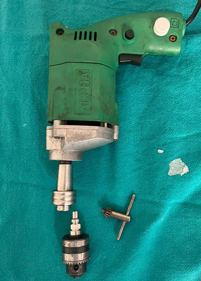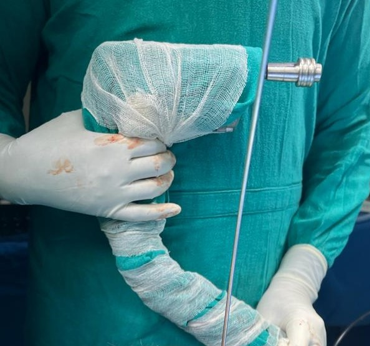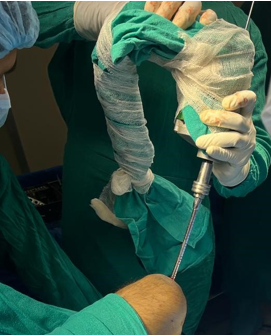- Visibility 189 Views
- Downloads 37 Downloads
- Permissions
- DOI 10.18231/j.jsas.2022.023
-
CrossMark
- Citation
Abstract
Bone is a dense, mineral-rich tissue with organic components. Implants such as plates and nails are used to reconstruct fractures. In orthopedic surgery, broad-spectrum of drills ranges from pneumatic to battery-operated to electric drills. Each drill has its own set of benefits and drawbacks.
Though the standard of care, the orthopedic battery drill, and pneumatic drills are costly, the expense of maintenance is too high. Orthopedic surgeons frequently employ alternatives such as the Bosch battery drill and a corded electric drill in developing nations. These drills are inexpensive, but they cannot be used for reaming. Furthermore, some models have a constant speed, making them difficult to utilize for reaming.
We offer drill modifications to control the speed and use it for reaming. The literature has abundant evidence to dismiss misconceptions concerning electric drill overheating and bone thermal necrosis. There are multiple scientifically documented methods for effectively sterilizing an electric drill. Due to its affordability and ease of maintenance, our innovations, such as speed control and drill cannulation, enable us to adopt it for most trauma surgeries, particularly in developing nations.
Introduction
Bone is a dense tissue constituted of minerals and organic components. The repair of a fracture necessitates implants such as plates and nails. These procedures involve drilling into the bone. Drilling produces two forces: a thrust and a cutting force. The thrust force acts in the opposite direction of the drilling and is related to the type of bone drilled. The cortical bone, for example, generates a greater thrust force than the cancellous bone. On the other hand, the drill speed, torque, and diameter of the drill bit all influence the amount of cutting force emitted at the bit's cutting edge.
A wide array of drills ranging from pneumatic to battery-operated drills and even electric drills are utilized in orthopedic surgery. Each drill has its unique set of advantages and disadvantages. Because of its benefits, most trauma surgeons in the developing world prefer the electric drill. The pros include cost-effectiveness, ease of use, and reusability. [1]



|
Specifications |
Electric Drill (Modified) |
Orthopedic Battery drill (Stryker system 6) |
Bosch Battery Drill Model number GSB 180 |
|
Weight |
1.5 kg |
1.7 kg with battery |
3.44 kg with battery |
|
Speed |
2800 RPM |
Up to 1500 RPM |
Up to 1700 |
|
Sterilization |
EtO, Formalin chamber, Formalin Autoclav |
Autoclave, EtO |
Formalin chamber, EtO |
|
Reaming |
Possible |
Possible |
Not Possible |
|
Drilling |
Possible |
Possible |
Possible |
|
K-wire |
Possible |
Possible |
Possible |
|
Wattage Battery |
220-230W NA |
220 -230 W 14 V on the charger |
220-230 W 18 V |
|
Torque |
Not specified, but more than battery drills |
Not specified in the brochure |
54 Newton meters |
|
Price USD |
50 |
7840 |
210 |
|
Maintenance |
Very Cheap and freely available |
Very high with a considerable lag time |
Cheap and freely available |
Technical note
The prototype of the drill used by us is from a local manufacturer—[[Figure 1]]. The handpiece is wholly made of plastic, while the initial part of the body meant for chuck attachment is made of iron. We replaced the original Jacobson chuck with a stainless steel coupling to hold the reamer for nailing. The initial iron chuck was replaced with a stainless steel chuck. There were three reasons to do that: 1. we had to modify the chuck to fit in the coupling 2. Since the chuck could be detached from the drill, we could autoclave it 3.Steel chuck is corrosion resistant, and with constant exposure to blood and water during surgery, there was a high likelihood that the original iron chuck would corrode and increase the chances of infection. This chuck was equipped with three jaws that securely grasped the drill bit or K wire and opened and closed with a key. The ergonomically built handpiece features a cord for the power supply. We increased the power cable length to seven meters to keep it out of reach of anesthesia equipment and oxygen cylinder. The original drill had a constant speed, so we modified the speed control using a knob to alter the pace depending on whether we used it to drill holes in bone or ream.
To maintain the drill's sterility, we placed the drill in a formalin chamber and autoclaved the detachable chuck. In addition to the above modifications, we made the drill cannulated to allow the guidewire to pass through while reaming. Alternatively, we use EtO (Ethylene Oxide) for sterilization of the drill. The drill is removed from the box and covered with a sterile sheet and bandage [[Figure 2]]. Following surgery, the sheet is removed, and any blood is cleaned from the surface with alcohol and hydrogen peroxide. We can also use a camera cover used in arthroscopy or a stockinet to cover the drill or make one permanent drill cover with a cloth and autoclave it every time before its use. After complete opening and closing of the jaws, special care is taken to clean the mouthpiece. The entire drill is cleaned with a spirit or alcohol-based compound before reinserting into the formalin chamber. We have successfully used the altered electric drill to perform interlocking nail placement in the tibia and femur of many patients. [[Figure 3]]
Discussion
While the pneumatic drill system (PDS) and the Orthopedic Battery Drill (OBD) are employed in orthopedic practice, their costs are incredibly high. The pneumatic drill system is equipped with a robust hose, restricting the surgeon's mobility when targeting screws at an angle. The primary advantage of a battery drill is the freedom with which it may be maneuvered in desired directions without using a hose or cable. The downside of battery drills is that the drill's 12V battery must be charged for 25 minutes to 240 minutes before usage. The batteries must be replaced between surgeries, increasing operating time and jeopardizing sterilization. Another issue with the battery drill is that its torque decreases as the battery charge depletes.
An electric drill costs approximately 1500 Indian rupees (20 US Dollars), and the hardware required to modify reaming system costs an additional 2500 Indian rupees (approx 30 US dollars), which may serve as another excellent replacement. Our electric drill with reaming design costs almost a quarter of Bosch battery drills without reaming capability. In contrast, conventional Orthopedic battery drills and pneumatic drill systems cost 150 times. Concerns about sterility, heat necrosis of bone, power cord concerns, and drill maintenance are the most common reservations about using electric drills in orthopedic surgery.
Matthews and Hirsch observed no significant change in temperature when drilling human cadaveric femora at rates ranging from 345 to 2900 revolutions per minute, indicating that overheating was more dependent on the drilling pressure.[2] Sharawy proved in a comparable study that raising rotational speed from 1225 to 2500 rpm reduced heat output.[3] The bit design, bone tissue resistance, rotational speed, and force produced at the cutting edge of the drill bit contribute to bone heat generation and thermal necrosis.[4] While it is widely believed that an electric drill is insufficient for bone use, resulting in splintering/overheating, etc. However, when we evaluated the Bosch battery drill, Stryker system 6, and an electric drill, we discovered they are all comparable in terms of RPM and weight ([Table 1]).
Because the electric drill is manufactured of plastic and iron, it cannot be autoclaved. Goveia et al. investigated the efficacy of Ethylene Oxide (EtO) in sterilizing electric drills. They confirmed that this process is safe and effective in sanitizing and reusing electric drills.[5] We housed our drill in a formalin chamber because Taylor and Barbeito demonstrated formaldehyde gas thoroughly decontaminated laboratory chambers and scientific instruments in 1969. The source of this gas was paraformaldehyde powder. It suppressed both sporicidal and nonsporicidal bacteria and neutralized toxins and viruses. Formaldehyde, often known as formalin, was excellent disinfection for facemasks from the COVID 19 virus by Haro et al. in 202.[6] Electric drills can also be autoclaved in a Formalin autoclave at 65 degrees Celsius. Residual formalin is negligible with an autoclave, and sterilization levels are comparable to Ethylene Oxide.[7]
Following the surgery, the drills' surface is cleaned with alcohol and hydrogen peroxide before placing it in the formalin chamber. We also draped the drill with autoclaved stockinet or drapes to avoid direct contact with blood and water during operation and to enhance protection.[8] Alternatively, we can also employ the ready-to-use sterile camera covers to prevent smudging with blood and boost its longevity.
We can not only drill K-wires with the modified electric drill but also ream the medullary canal and tap utilizing the reverse and forward triggers. Among the disadvantages of using an electric drill are the inability to attach the K-wire collet system, the lack of a paired saw system, and, albeit minor, cable concerns. The electric drill has most of the functionality of a premium orthopedic drill for less than 150 times the price. We eliminated a significant disadvantage by cannulating it, making it comparable to Orthopedic Battery drills. As a result, we encourage and advocate for the routine use of electric drills without reservation in most trauma procedures, including nail reaming in countries with limited resources.
Conclusion
The literature contains adequate evidence to refute misconceptions about electric drill overheating and bone thermal necrosis. There are various scientifically validated methods for sterilizing the electric drill effectively. Due to its affordability and ease of maintenance, particularly in poor economies, our inventions such as speed control and drill cannulation make it an all-purpose piece of equipment for most trauma surgeries.
Source of Funding
None.
Declaration of Interest
We did not receive any specific support from funding agencies in the public, commercial, or not-for-profit entities.
Ethical Statement
We explained the procedure to the patient in his native language and obtained permission to submit the article and accompanying photographs for publication.
References
- Railton R, Pringle R, Shaw A. Evaluation of Makita electric drills for orthopedic surgery. J Med Eng Technol. 1988;12(1):20-3. [Google Scholar]
- Matthews LS, Hirsch C. Temperatures measured in human cortical bone when drilling. J Bone Joint Surg Am. 1972;54(2):297-308. [Google Scholar]
- Sharawy M, Misch C, Weller N, Tehemar S. Heat generation during implant drilling: the significance of motor speed. J Oral Maxillofac Surg. 2002;60(10):1160-9. [Google Scholar]
- Pazarci O, Torun Y, Ozturk A, Oztemur Z. Comparative Study of Different Drills for Bone Drilling: A Systematic Approach,” Malays. Orthop J. 2020;14(2):83-9. [Google Scholar]
- Goveia VR, Pinto FG, Machoshvili I, Penna T, Graziano K. Evaluation of the sterilization efficacy of domestic electric drills used in orthopedic surgeries. Braz J Microbiol Publ Braz Soc Microbiol. 2009;40(3):541-6. [Google Scholar]
- Haro MG. Decontamination of filtering facepiece respirators using a low-temperature-steam-2%-formaldehyde sterilization process during a pandemic: a safe alternative for reuse. J Hosp Infect. 2021;108:113-9. [Google Scholar]
- Nyström B. New technology for sterilization and disinfection. Am J Med. 1991;91(3):264-6. [Google Scholar]
- Buchan LL. Making Safe Surgery Affordable: Design of a Surgical Drill Cover System for Scale. J Orthop Trauma. 2015;29(10):29-32. [Google Scholar]
How to Cite This Article
Vancouver
Makkar D. The electric drill to better use [Internet]. IP J Surg Allied Sci. 2022 [cited 2025 Oct 10];4(3):122-125. Available from: https://doi.org/10.18231/j.jsas.2022.023
APA
Makkar, D. (2022). The electric drill to better use. IP J Surg Allied Sci, 4(3), 122-125. https://doi.org/10.18231/j.jsas.2022.023
MLA
Makkar, Dheeraj. "The electric drill to better use." IP J Surg Allied Sci, vol. 4, no. 3, 2022, pp. 122-125. https://doi.org/10.18231/j.jsas.2022.023
Chicago
Makkar, D.. "The electric drill to better use." IP J Surg Allied Sci 4, no. 3 (2022): 122-125. https://doi.org/10.18231/j.jsas.2022.023
